8.E: Further Applications of Trigonometry (Exercises)
( \newcommand{\kernel}{\mathrm{null}\,}\)
8.1: Non-right Triangles: Law of Sines
Verbal
1) Describe the altitude of a triangle.
- Answer
-
The altitude extends from any vertex to the opposite side or to the line containing the opposite side at a
2) Compare right triangles and oblique triangles.
3) When can you use the Law of Sines to find a missing angle?
- Answer
-
When the known values are the side opposite the missing angle and another side and its opposite angle.
4) In the Law of Sines, what is the relationship between the angle in the numerator and the side in the denominator?
5) What type of triangle results in an ambiguous case?
- Answer
-
A triangle with two given sides and a non-included angle.
Algebraic
For the exercises 6-10, assume
6)
7)
- Answer
-
8)
9)
- Answer
-
10)
11) Find side
- Answer
-
12) Find side
13) Find side
- Answer
-
For the exercises 14-23, assume
14)
15)
- Answer
-
one triangle,
16)
17)
- Answer
-
two triangles,
18)
19)
- Answer
-
two triangles,
20)
21)
- Answer
-
two triangles,
22)
23)
- Answer
-
no triangle possible
For the exercises 24-26, use the Law of Sines to solve, if possible, the missing side or angle for each triangle or triangles in the ambiguous case. Round each answer to the nearest tenth.
24) Find angle
25) Find angle
- Answer
-
26) Find angle
For the exercises 27-30, find the area of the triangle with the given measurements. Round each answer to the nearest tenth.
27)
- Answer
-
28)
29)
- Answer
-
30)
Graphical
For the exercises 31-36, find the length of side
31)
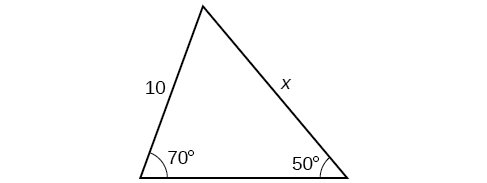
- Answer
-
32)
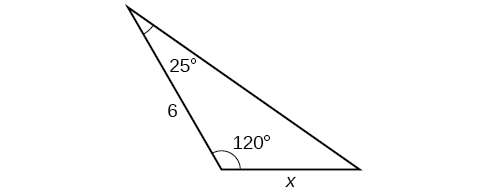
33)

- Answer
-
34)
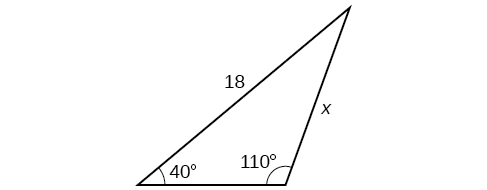
35)

- Answer
-
36)

For the exercises 37-,42 find the measure of angle
37)

- Answer
-
38)
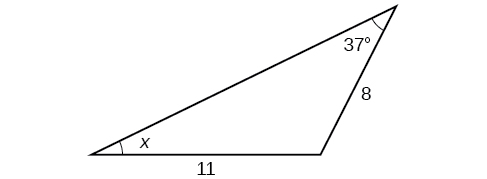
39)

- Answer
-
40)

41) Notice that
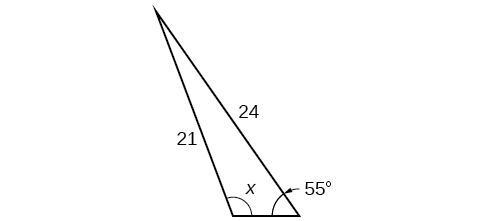
- Answer
-
42)
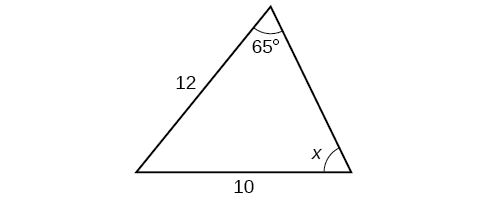
For the exercises 43-49, find the area of each triangle. Round each answer to the nearest tenth.
43)
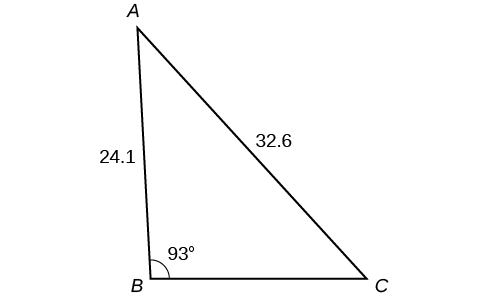
- Answer
-
44)
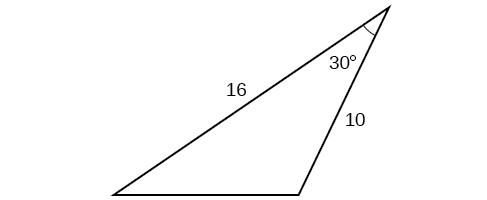
45)
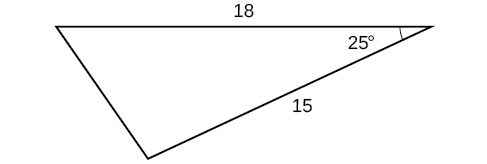
- Answer
-
46)

47)
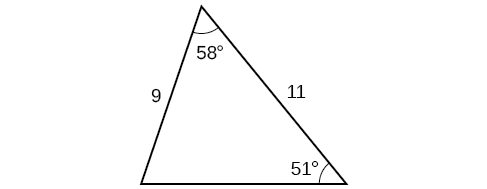
- Answer
-
48)
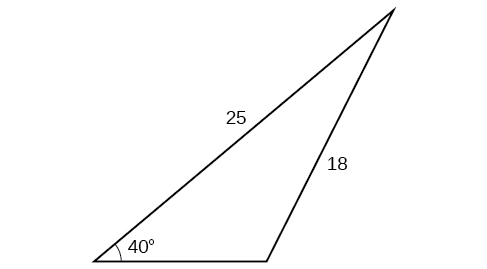
49)

- Answer
-
Extensions
50) Find the radius of the circle in the Figure below. Round to the nearest tenth.
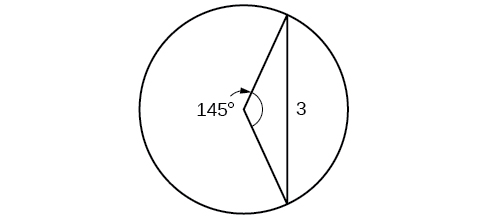
51) Find the diameter of the circle in the Figure below. Round to the nearest tenth.
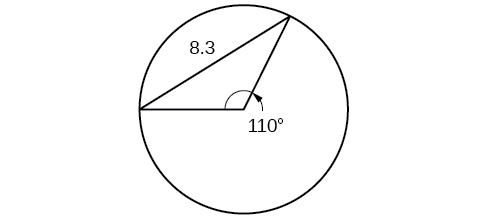
- Answer
-
52) Find
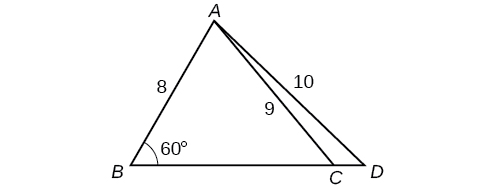
53) Find side
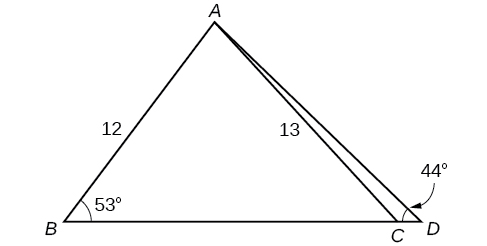
- Answer
-
54) Solve both triangles in the Figure below. Round each answer to the nearest tenth.
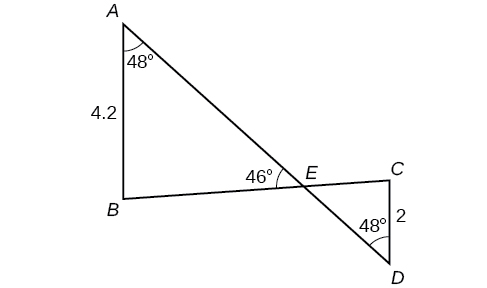
55) Find side
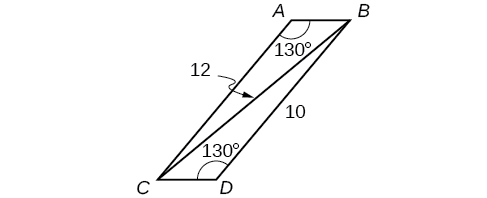
- Answer
-
56) Solve the triangle in the Figure below. (Hint: Draw a perpendicular from

57) Solve the triangle in the Figure below. (Hint: Draw a perpendicular from

- Answer
-
58) In the Figure below,
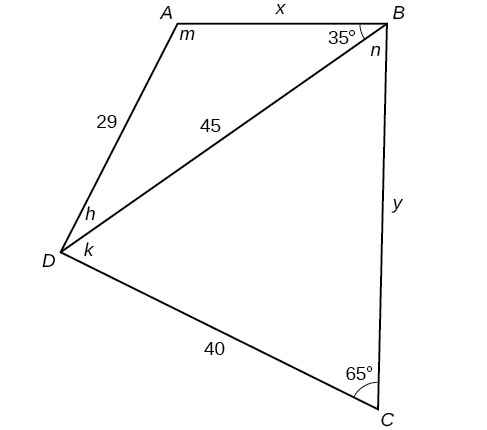
Real-World Applications
59) A pole leans away from the sun at an angle of
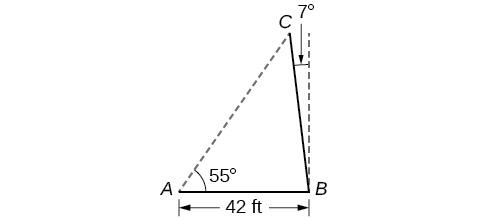
- Answer
-
60) To determine how far a boat is from shore, two radar stations
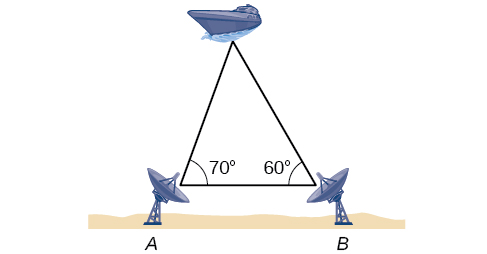
61) The Figure below shows a satellite orbiting Earth. The satellite passes directly over two tracking stations
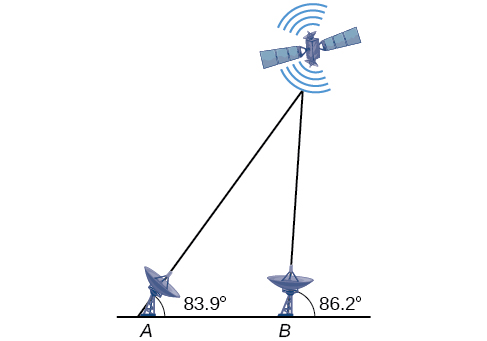
- Answer
-
The distance from the satellite to station
62) A communications tower is located at the top of a steep hill, as shown in the Figure below. The angle of inclination of the hill is
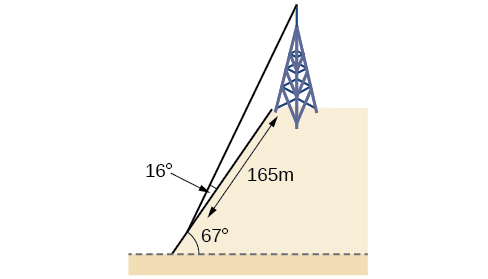
63) The roof of a house is at a
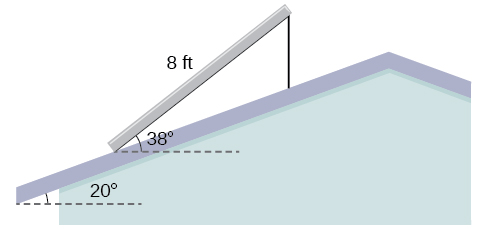
- Answer
-
64) Similar to an angle of elevation, an angle of depression is the acute angle formed by a horizontal line and an observer’s line of sight to an object below the horizontal. A pilot is flying over a straight highway. He determines the angles of depression to two mileposts,
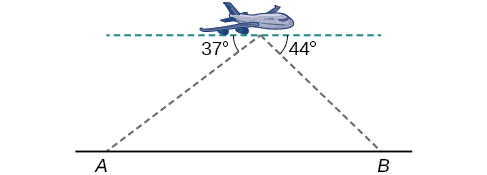
65) A pilot is flying over a straight highway. He determines the angles of depression to two mileposts,
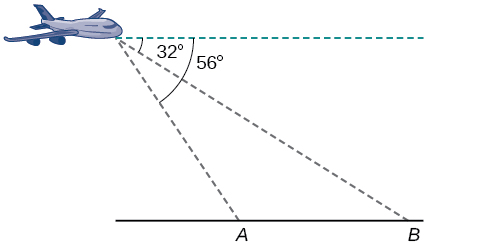
- Answer
-
66) In order to estimate the height of a building, two students stand at a certain distance from the building at street level. From this point, they find the angle of elevation from the street to the top of the building to be
67) In order to estimate the height of a building, two students stand at a certain distance from the building at street level. From this point, they find the angle of elevation from the street to the top of the building to be
- Answer
-
68) Points
69) A man and a woman standing
- Answer
-
70) Two search teams spot a stranded climber on a mountain. The first search team is
71) A street light is mounted on a pole. A
- Answer
-
72) Three cities,
73) Two streets meet at an
- Answer
-
74) Brian’s house is on a corner lot. Find the area of the front yard if the edges measure

75) The Bermuda triangle is a region of the Atlantic Ocean that connects Bermuda, Florida, and Puerto Rico. Find the area of the Bermuda triangle if the distance from Florida to Bermuda is
- Answer
-
76) A yield sign measures
77) Naomi bought a modern dining table whose top is in the shape of a triangle. Find the area of the table top if two of the sides measure

- Answer
-
8.2: Non-right Triangles - Law of Cosines
Verbal
1) If you are looking for a missing side of a triangle, what do you need to know when using the Law of Cosines?
- Answer
-
two sides and the angle opposite the missing side.
2) If you are looking for a missing angle of a triangle, what do you need to know when using the Law of Cosines?
3) Explain what
- Answer
-
4) Explain the relationship between the Pythagorean Theorem and the Law of Cosines.
5) When must you use the Law of Cosines instead of the Pythagorean Theorem?
- Answer
-
The Law of Cosines must be used for any oblique (non-right) triangle.
Algebraic
For the exercises 6-15, assume
6)
7)
- Answer
-
8)
9)
- Answer
-
10)
11)
- Answer
-
12)
13)
- Answer
-
14)
15)
- Answer
-
not possible
For the exercises 16-20, use the Law of Cosines to solve for the missing angle of the oblique triangle. Round to the nearest tenth.
16)
17)
- Answer
-
18)
19)
- Answer
-
20)
For the exercises 21-26, solve the triangle. Round to the nearest tenth.
21)
- Answer
-
22)
23)
- Answer
-
24)
25)
- Answer
-
26)
For the exercises 27-,31 use Heron’s formula to find the area of the triangle. Round to the nearest hundredth.
27) Find the area of a triangle with sides of length
- Answer
-
28) Find the area of a triangle with sides of length
29)
- Answer
-
30)
31)
- Answer
-
Graphical
For the exercises 32-37, find the length of side
32)
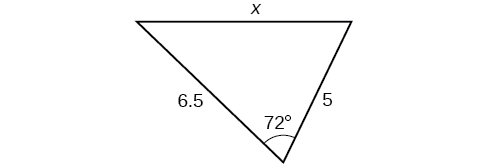
33)
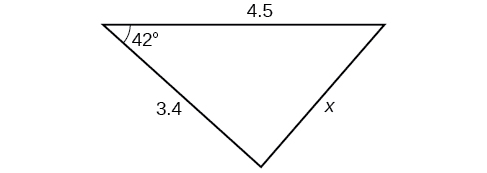
- Answer
-
34)
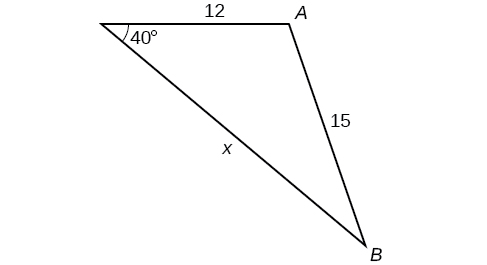
35)
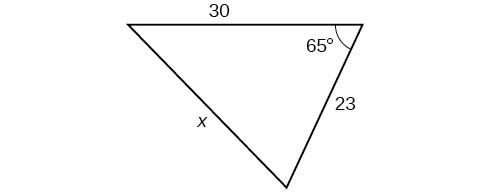
- Answer
-
36)
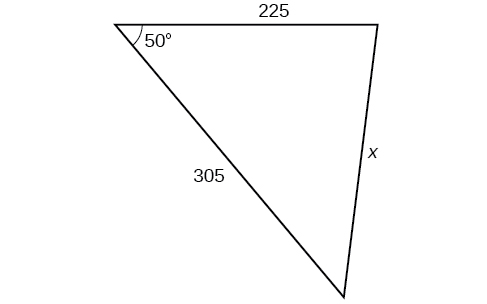
37)

- Answer
-
For the exercises 38-41, find the measurement of angle
38)
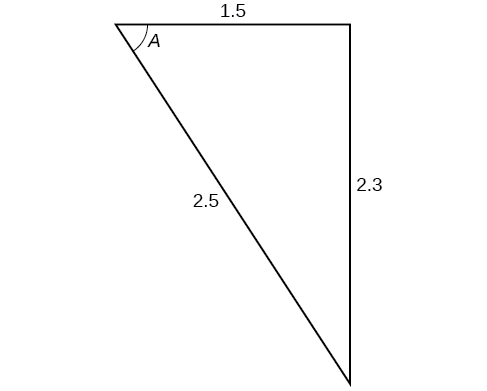
39)
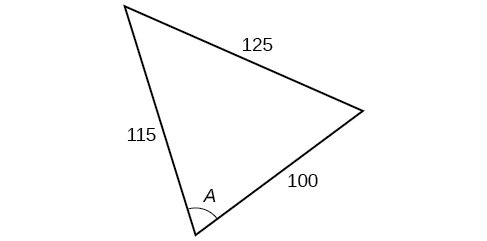
- Answer
-
40)
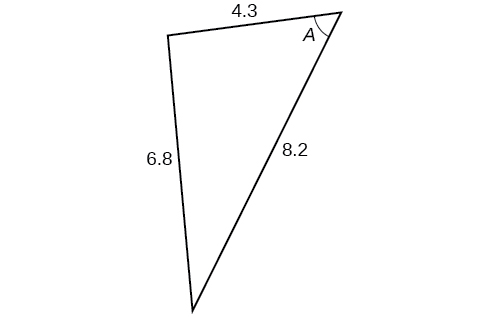
41)
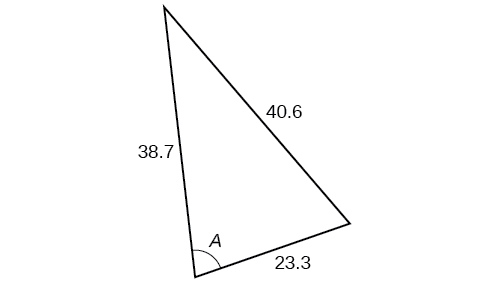
- Answer
-
42) Find the measure of each angle in the triangle shown in the Figure below. Round to the nearest tenth.

For the exercises 43-46, solve for the unknown side. Round to the nearest tenth.
43)
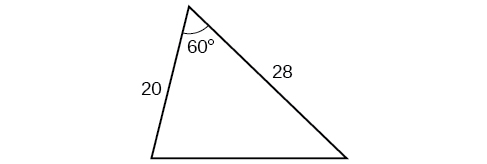
- Answer
-
44)
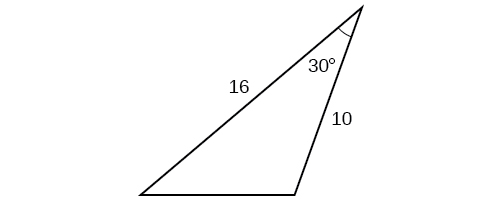
45)
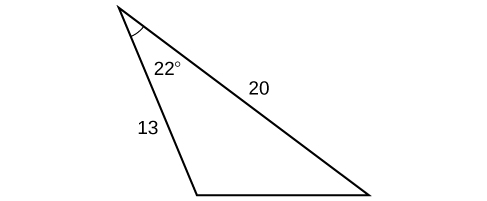
- Answer
-
46)
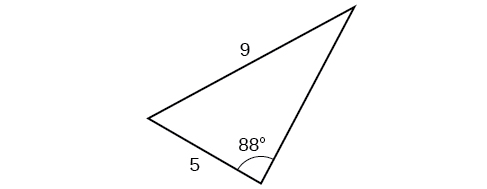
For the exercises 47-51, find the area of the triangle. Round to the nearest hundredth.
47)
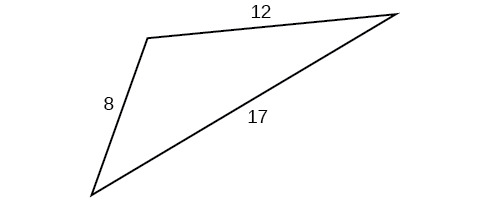
- Answer
-
48)
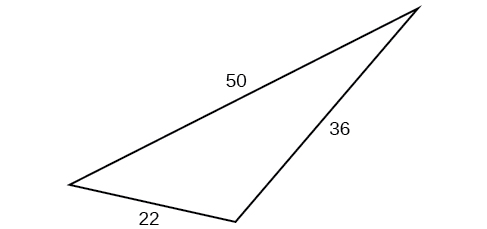
49)
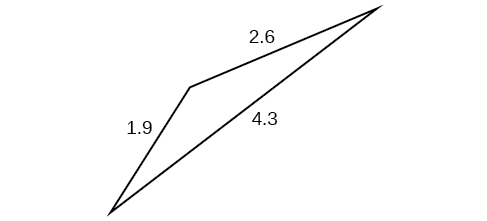
- Answer
-
50)
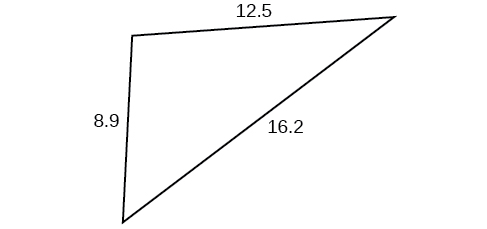
51)
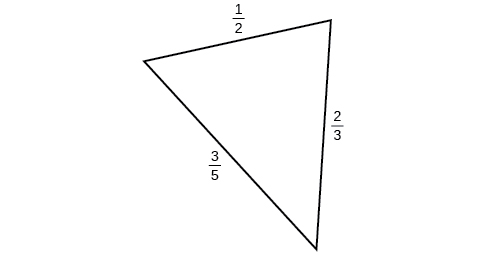
- Answer
-
Extensions
52) A parallelogram has sides of length
53) The sides of a parallelogram are
- Answer
-
54) The sides of a parallelogram are
55) A regular octagon is inscribed in a circle with a radius of
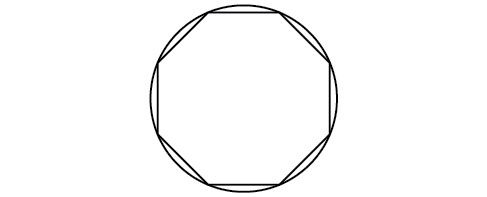
- Answer
-
56) A regular pentagon is inscribed in a circle of radius

For the exercises 57-58, suppose that
57) Draw the triangle.
- Answer
-

58) Find the length of the third side.
For the exercises 59-61, find the area of the triangle.
59)

- Answer
-
60)

61)
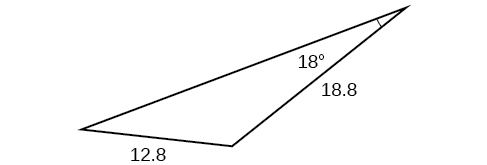
- Answer
-
Real-World Applications
62) A surveyor has taken the measurements shown in the Figure below. Find the distance across the lake. Round answers to the nearest tenth.
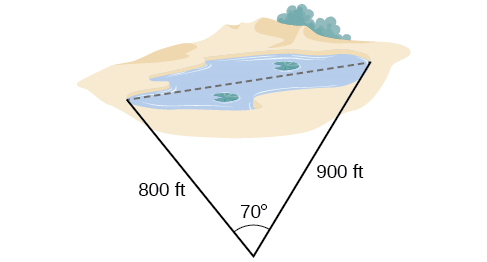
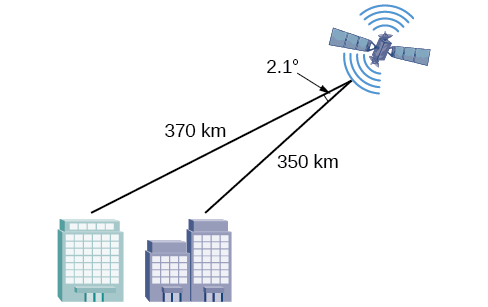
- Answer
-
64) An airplane flies
65) A
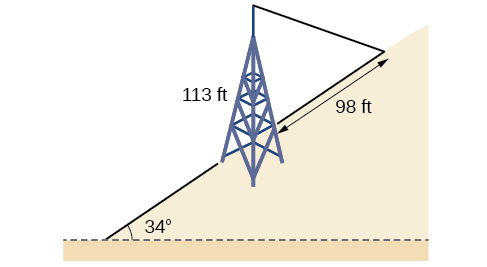
- Answer
-
66) Two ships left a port at the same time. One ship traveled at a speed of
67) The graph in the Figure below represents two boats departing at the same time from the same dock. The first boat is traveling at
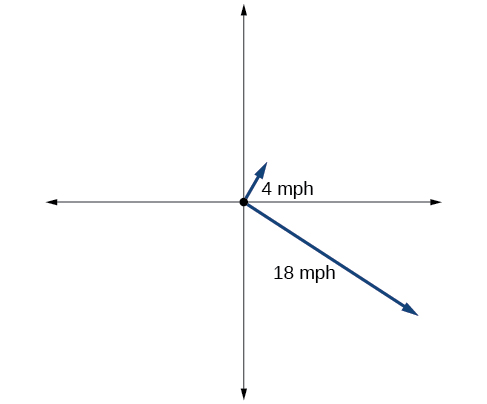
- Answer
-
68) A triangular swimming pool measures
69) A pilot flies in a straight path for
- Answer
-
70) Los Angeles is
71) Philadelphia is
- Answer
-

72) Two planes leave the same airport at the same time. One flies at
73) Two airplanes take off in different directions. One travels
- Answer
-
74) A parallelogram has sides of length
75) The four sequential sides of a quadrilateral have lengths
- Answer
-
76) The four sequential sides of a quadrilateral have lengths
77) Find the area of a triangular piece of land that measures
- Answer
-
78) Find the area of a triangular piece of land that measures
8.3: Polar Coordinates
Verbal
1) How are polar coordinates different from rectangular coordinates?
- Answer
-
For polar coordinates, the point in the plane depends on the angle from the positive
2) How are the polar axes different from the
3) Explain how polar coordinates are graphed.
- Answer
-
Determine
4) How are the points
5) Explain why the points
- Answer
-
The point
Algebraic
6)
7)
- Answer
-
8)
9)
- Answer
-
10)
For the exercises 11-15, convert the given Cartesian coordinates to polar coordinates with
11)
- Answer
-
12)
13)
- Answer
-
14)
15)
- Answer
-
For the exercises 16-27, convert the given Cartesian equation to a polar equation.
16)
17)
- Answer
-
18)
19)
- Answer
-
20)
21)
- Answer
-
22)
23)
- Answer
-
24)
25)
- Answer
-
26)
27)
- Answer
-
For the exercises 28-39, convert the given polar equation to a Cartesian equation. Write in the standard form of a conic if possible, and identify the conic section represented.
28)
29)
- Answer
-
30)
31)
- Answer
-
32)
33)
- Answer
-
34)
35)
- Answer
-
36)
37)
- Answer
-
38)
39)
- Answer
-
Graphical
For the exercises 40-44, find the polar coordinates of the point.
40)
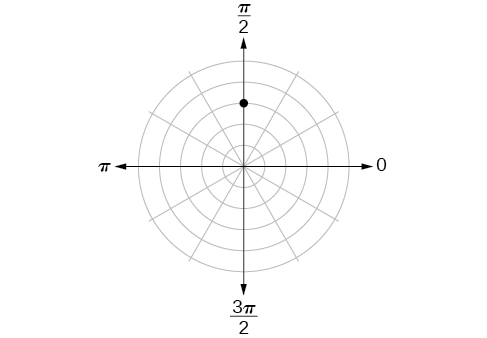
41)
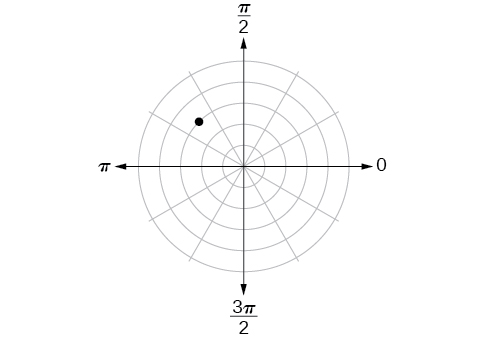
- Answer
-
42)
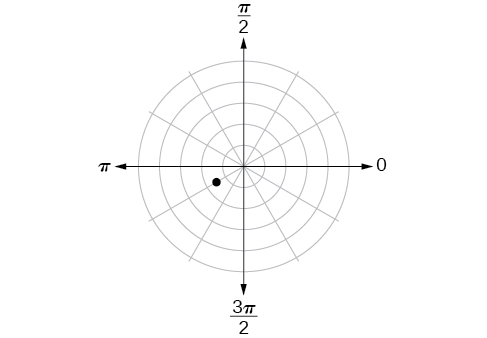
43)
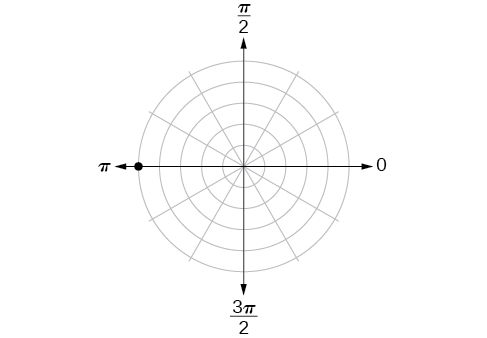
- Answer
-
44)
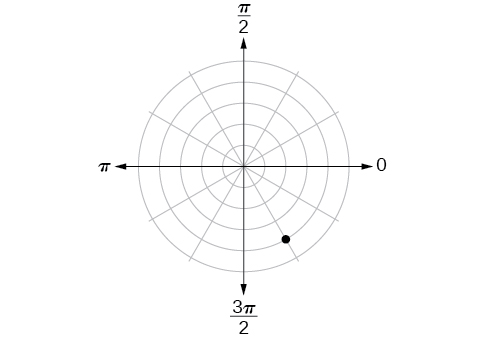
For the exercises 45-54, plot the points.
45)
- Answer
-
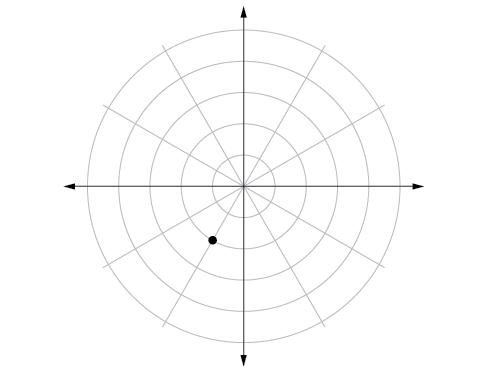
46)
47)
- Answer
-
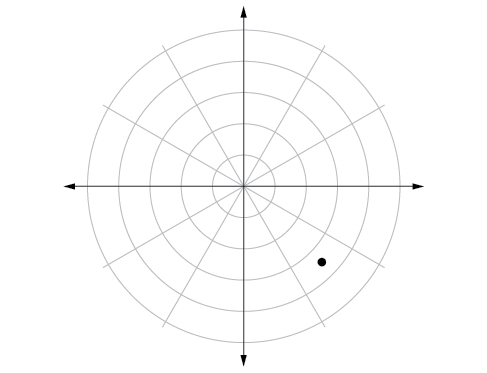
48)
49)
- Answer
-
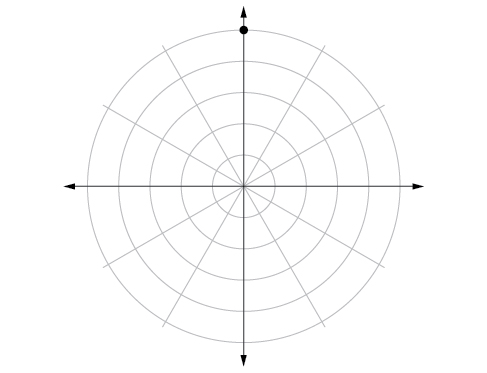
50)
51)
- Answer
-
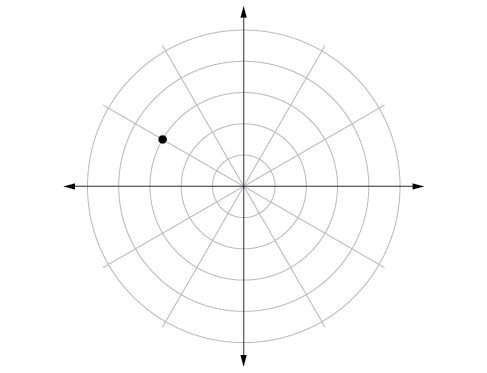
52)
53)
- Answer
-
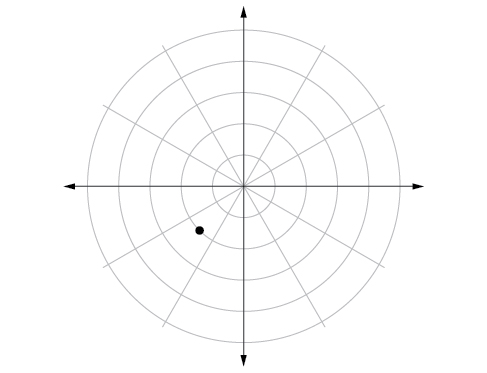
54)
For the exercises 55-61, convert the equation from rectangular to polar form and graph on the polar axis.
55)
- Answer
-
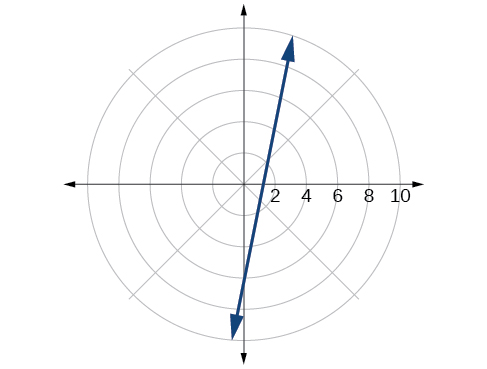
56)
57)
- Answer
-
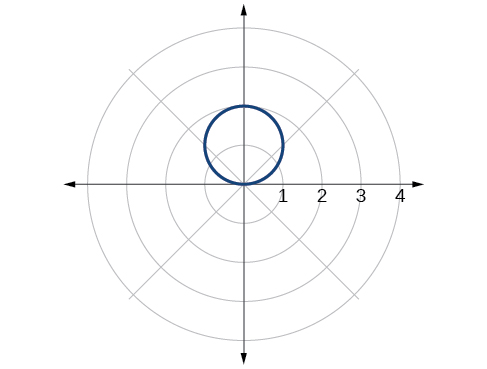
58)
59)
- Answer
-
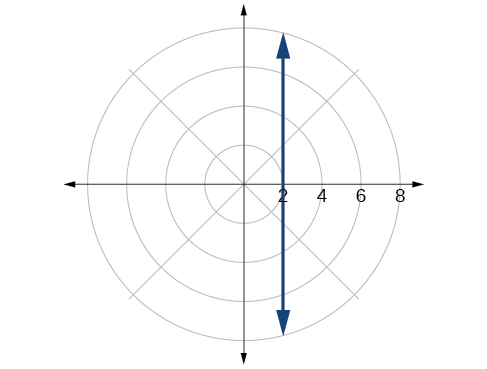
60)
61)
- Answer
-

For the exercises 62-68, convert the equation from polar to rectangular form and graph on the rectangular plane.
62)
63)
- Answer
-

64)
65)
- Answer
-
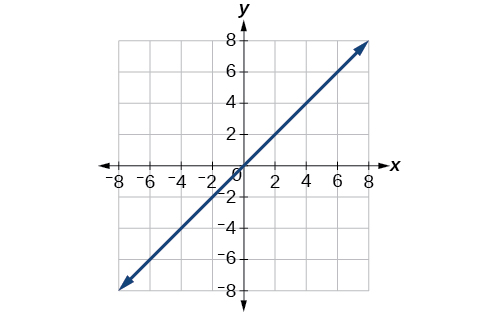
66)
67)
- Answer
-
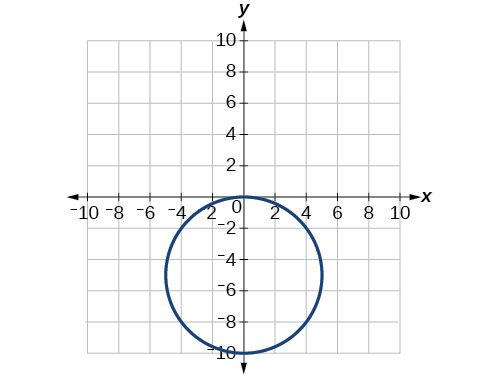
68)
Technology
69) Use a graphing calculator to find the rectangular coordinates of
- Answer
-
70) Use a graphing calculator to find the rectangular coordinates of
71) Use a graphing calculator to find the polar coordinates of
- Answer
-
72) Use a graphing calculator to find the polar coordinates of
73) Use a graphing calculator to find the polar coordinates of
- Answer
-
Extensions
74) Describe the graph of
75) Describe the graph of
- Answer
-
A vertical line with
76) Describe the graph of
77) Describe the graph of
- Answer
-
A horizontal line with
78) What polar equations will give an oblique line?
For the exercises 79-84, graph the polar inequality.
79)
- Answer
-
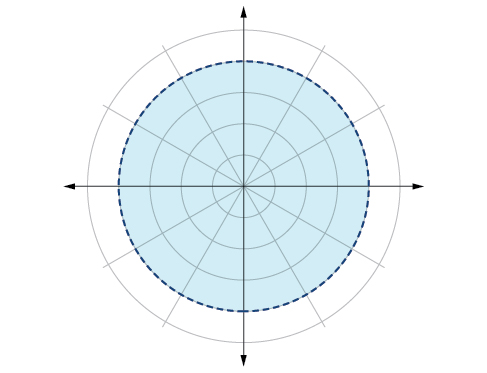
80)
81)
- Answer
-
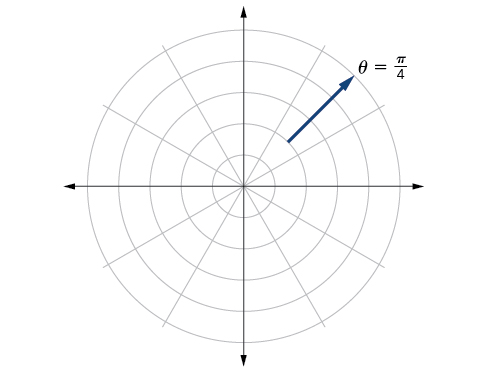
82)
83)
- Answer
-
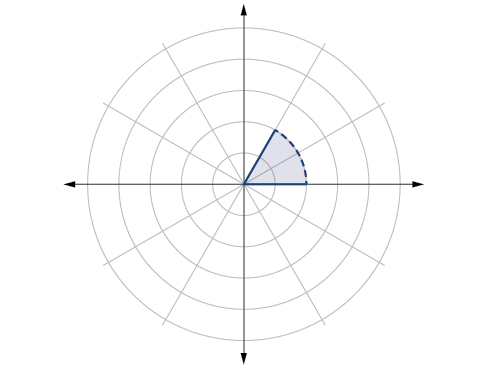
84)
8.4: Polar Coordinates - Graphs
Verbal
1) Describe the three types of symmetry in polar graphs, and compare them to the symmetry of the Cartesian plane.
- Answer
-
Symmetry with respect to the polar axis is similar to symmetry about the
2) Which of the three types of symmetries for polar graphs correspond to the symmetries with respect to the
3) What are the steps to follow when graphing polar equations?
- Answer
-
Test for symmetry; find zeros, intercepts, and maxima; make a table of values. Decide the general type of graph, cardioid, limaçon, lemniscate, etc., then plot points at
4) Describe the shapes of the graphs of cardioids, limaçons, and lemniscates.
5) What part of the equation determines the shape of the graph of a polar equation?
- Answer
-
The shape of the polar graph is determined by whether or not it includes a sine, a cosine, and constants in the equation.
Graphical
For the exercises 6-15, test the equation for symmetry.
6)
7)
- Answer
-
symmetric with respect to the polar axis
8)
9)
- Answer
-
symmetric with respect to the polar axis, symmetric with respect to the line
,
10)
11)
- Answer
-
no symmetry
12)
13)
- Answer
-
no symmetry
14)
15)
- Answer
-
symmetric with respect to the pole
For the exercises 16-43, graph the polar equation. Identify the name of the shape.
16)
17)
- Answer
-
circle
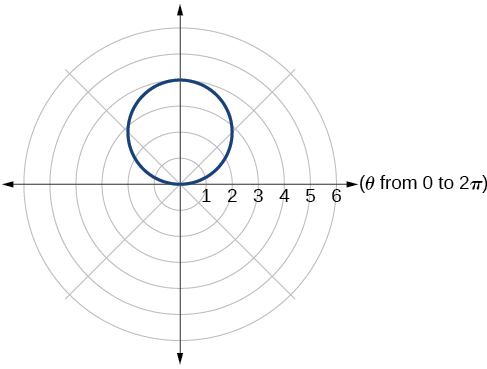
18)
19)
- Answer
-
cardioid
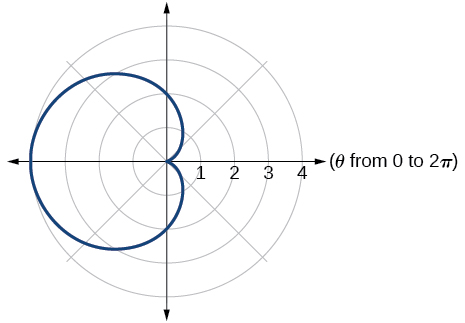
20)
21)
- Answer
-
cardioid
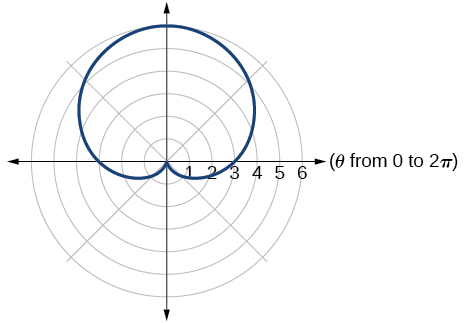
22)
23)
- Answer
-
one-loop/dimpled limaçon
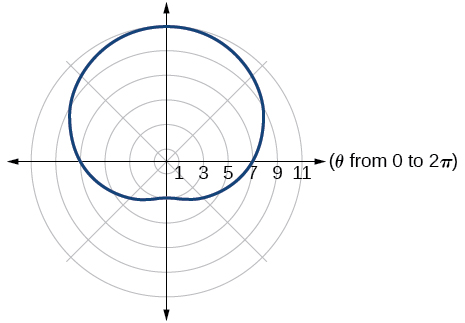
24)
25)
- Answer
-
one-loop/dimpled limaçon
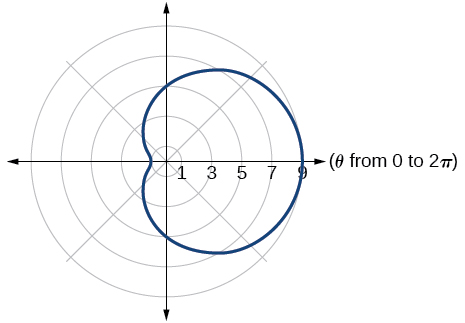
26)
27)
- Answer
-
inner loop/ two-loop limaçon
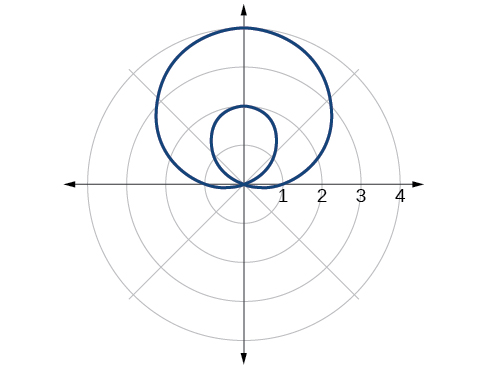
28)
29)
- Answer
-
inner loop/ two-loop limaçon

30)
31)
- Answer
-
inner loop/ two-loop limaçon
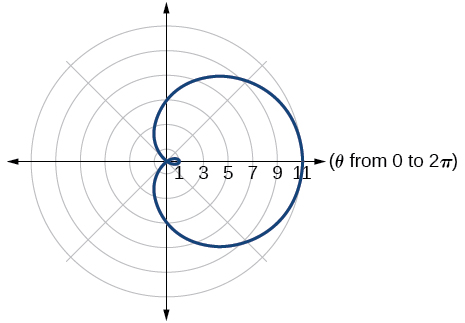
32)
33)
- Answer
-
lemniscate
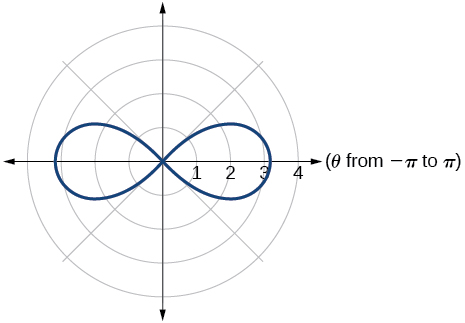
34)
35)
- Answer
-
lemniscate
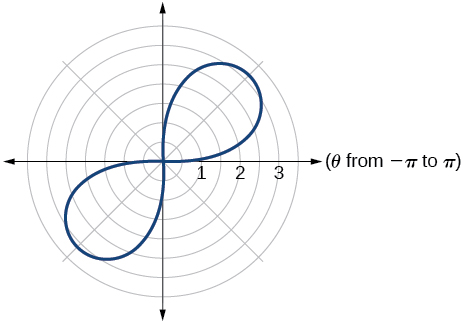
36)
37)
- Answer
-
rose curve
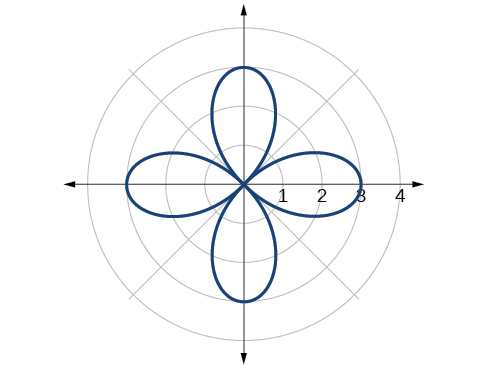
38)
39)
- Answer
-
rose curve
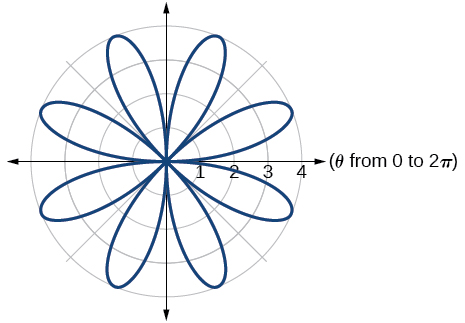
40)
41)
- Answer
-
Archimedes’ spiral
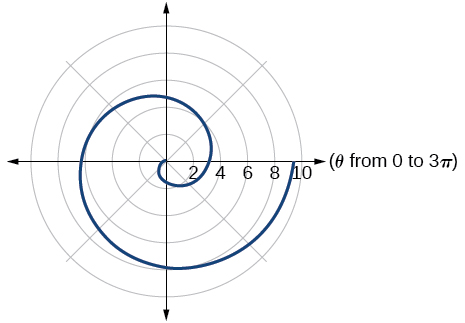
42)
43)
- Answer
-
Archimedes’ spiral
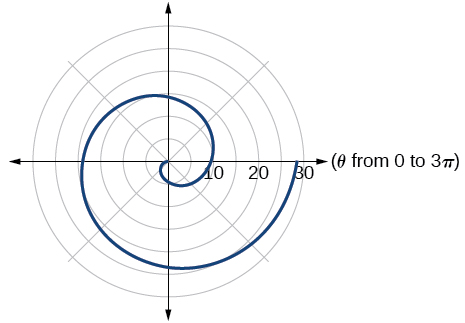
Technology
For the exercises 44-53, use a graphing calculator to sketch the graph of the polar equation.
44)
45)
- Answer
-

46)
47)
- Answer
-
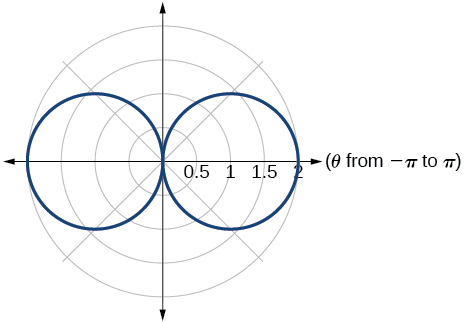
48)
49)
- Answer
-
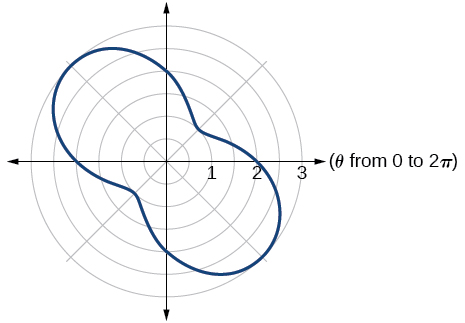
50)
51)
- Answer
-
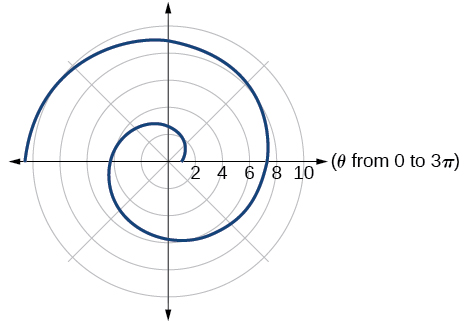
52)
53)
- Answer
-
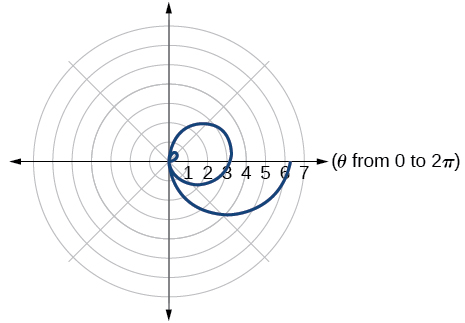
For the exercises 54-63, use a graphing utility to graph each pair of polar equations on a domain of
54)
55)
- Answer
-
They are both spirals, but not quite the same.
56)
57)
- Answer
-
Both graphs are curves with
58)
59) On a graphing utility, graph
- Answer
-
When the width of the domain is increased, more petals of the flower are visible.
60) On a graphing utility, graph and sketch
61) On a graphing utility, graph each polar equation. Explain the similarities and differences you observe in the graphs.
- Answer
-
The graphs are three-petal, rose curves. The larger the coefficient, the greater the curve’s distance from the pole.
62) On a graphing utility, graph each polar equation. Explain the similarities and differences you observe in the graphs.
63) On a graphing utility, graph each polar equation. Explain the similarities and differences you observe in the graphs.
- Answer
-
The graphs are spirals. The smaller the coefficient, the tighter the spiral.
Extensions
For the exercises 64-72, draw each polar equation on the same set of polar axes, and find the points of intersection.
64)
65)
- Answer
-
66)
67)
- Answer
-
68)
69)
- Answer
-
70)
71)
- Answer
-
72)
8.5: Polar Form of Complex Numbers
Verbal
1) A complex number is
- Answer
-
2) What does the absolute value of a complex number represent?
3) How is a complex number converted to polar form?
- Answer
-
Polar form converts the real and imaginary part of the complex number in polar form using
4) How do we find the product of two complex numbers?
5) What is De Moivre’s Theorem and what is it used for?
- Answer
-
It is used to simplify polar form when a number has been raised to a power.
Algebraic
For the exercises 6-11, find the absolute value of the given complex number.
6)
7)
- Answer
-
8)
9)
- Answer
-
10)
11)
- Answer
-
For the exercises 12-16, write the complex number in polar form.
12)
13)
- Answer
-
14)
15)
- Answer
-
16)
For the exercises 17-22, convert the complex number from polar to rectangular form.
17)
- Answer
-
18)
19)
- Answer
-
20)
21)
- Answer
-
22)
For the exercises 23-28, find
23)
- Answer
-
24)
25)
- Answer
-
26)
27)
- Answer
-
28)
For the exercises 29-,34 find
29)
- Answer
-
30)
31)
- Answer
-
32)
33)
- Answer
-
34)
For the exercises 35-40, find the powers of each complex number in polar form.
35) Find
- Answer
-
36) Find
37) Find
- Answer
-
38) Find
39) Find
- Answer
-
40) Find
For the exercises 41-45, evaluate each root.
41) Evaluate the cube root of
- Answer
-
42) Evaluate the square root of
43) Evaluate the cube root of
- Answer
-
44) Evaluate the square root of
45) Evaluate the cube root of
- Answer
-
Graphical
For the exercises 46-55, plot the complex number in the complex plane.
46)
47)
- Answer
-

48)
49)
- Answer
-
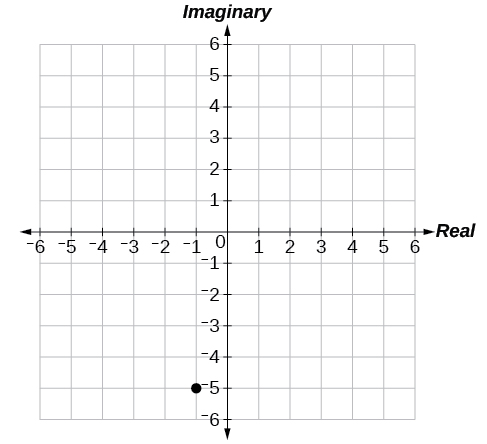
50)
51)
- Answer
-

52)
53)
- Answer
-
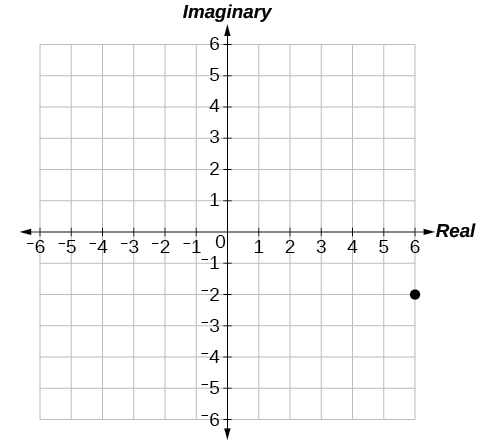
54)
55)
- Answer
-
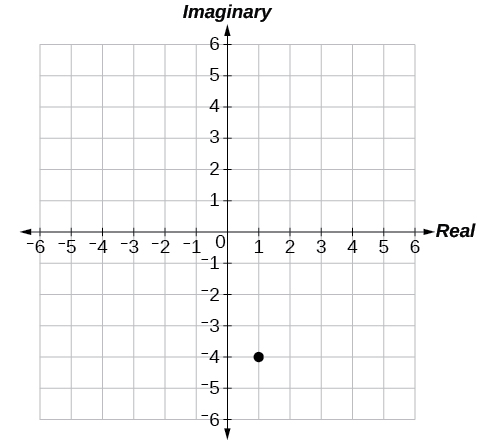
Technology
For the exercises 56-, find all answers rounded to the nearest hundredth.
56) Use the rectangular to polar feature on the graphing calculator to change
57) Use the rectangular to polar feature on the graphing calculator to change
- Answer
-
58) Use the rectangular to polar feature on the graphing calculator to change
59) Use the polar to rectangular feature on the graphing calculator to change
- Answer
-
60) Use the polar to rectangular feature on the graphing calculator to change
61) Use the polar to rectangular feature on the graphing calculator to change
- Answer
-
8.6: Parametric Equations
Verbal
1) What is a system of parametric equations?
- Answer
-
A pair of functions that is dependent on an external factor. The two functions are written in terms of the same parameter. For example,
2) Some examples of a third parameter are time, length, speed, and scale. Explain when time is used as a parameter.
3) Explain how to eliminate a parameter given a set of parametric equations.
- Answer
-
Choose one equation to solve for
4) What is a benefit of writing a system of parametric equations as a Cartesian equation?
5) What is a benefit of using parametric equations?
- Answer
-
Some equations cannot be written as functions, like a circle. However, when written as two parametric equations, separately the equations are functions.
6) Why are there many sets of parametric equations to represent on Cartesian function?
Algebraic
For the exercises 7-25, eliminate the parameter
7)
- Answer
-
8)
9)
- Answer
-
10)
11)
- Answer
-
12)
13)
- Answer
-
14)
15)
- Answer
-
16)
17)
- Answer
-
18)
19)
- Answer
-
20)
21)
- Answer
-
22)
23)
- Answer
-
24)
25)
- Answer
-
For the exercises 26-29, rewrite the parametric equation as a Cartesian equation by building an
26)
27)
- Answer
-
28)
29)
- Answer
-
For the exercises 30-33, parameterize (write parametric equations for) each Cartesian equation by setting
30)
31)
- Answer
-
32)
33)
- Answer
-
For the exercises 34-41, parameterize (write parametric equations for) each Cartesian equation by using
34)
35)
- Answer
-
36)
37)
- Answer
-
38) Parameterize the line from
39) Parameterize the line from
- Answer
-
40) Parameterize the line from
41) Parameterize the line from
- Answer
-
Technology
For the exercises 42-43, use the table feature in the graphing calculator to determine whether the graphs intersect.
42)
43)
- Answer
-
yes, at
For the exercises 44-46, use a graphing calculator to complete the table of values for each set of parametric equations.
44)
| -1 | ||
| 0 | ||
| 1 |
45)
| 1 | ||
| 2 | ||
| 3 |
- Answer
-
1 -3 1 2 0 7 3 5 17
46)
| -1 | ||
| 0 | ||
| 1 | ||
| 2 |
Extensions
47) Find two different sets of parametric equations for
- Answer
-
answers may vary:
48) Find two different sets of parametric equations for
49) Find two different sets of parametric equations for
- Answer
-
answers may vary:
8.7: Parametric Equations - Graphs
Verbal
1) What are two methods used to graph parametric equations?
- Answer
-
plotting points with the orientation arrow and a graphing calculator
2) What is one difference in point-plotting parametric equations compared to Cartesian equations?
3) Why are some graphs drawn with arrows?
- Answer
-
The arrows show the orientation, the direction of motion according to increasing values of
4) Name a few common types of graphs of parametric equations.
5) Why are parametric graphs important in understanding projectile motion?
- Answer
-
The parametric equations show the different vertical and horizontal motions over time.
Graphical
For the exercises 6-11, graph each set of parametric equations by making a table of values. Include the orientation on the graph.
6)
| -3 | ||
| -2 | ||
| -1 | ||
| 0 | ||
| 1 | ||
| 2 | ||
| 3 |
7)
| -3 | -2 | -1 | 0 | 1 | 2 | |
- Answer
-
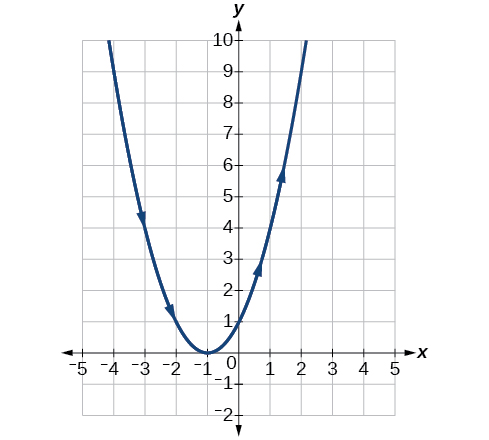
8)
| -2 | -1 | 0 | 1 | 2 | 3 | |
9)
| -3 | -2 | -1 | 0 | 1 | |
- Answer
-

10)
| -2 | -1 | 0 | 1 | 2 | |
11)
| -2 | -1 | 0 | 1 | 2 | |
- Answer
-
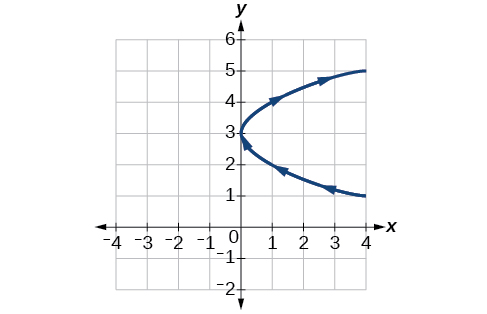
For the exercises 12-22, sketch the curve and include the orientation.
12)
13)
- Answer
-
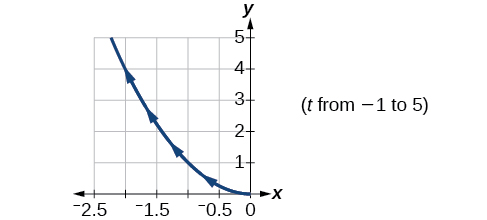
14)
15)
- Answer
-
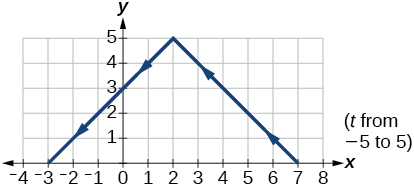
16)
17)
- Answer
-

18)
19)
- Answer
-
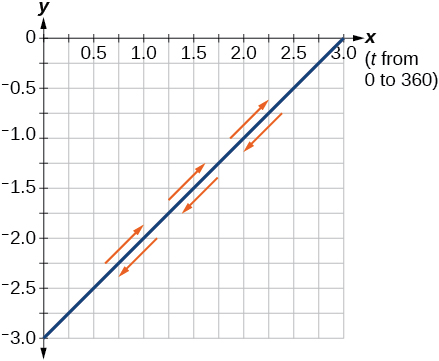
20)
21)
- Answer
-
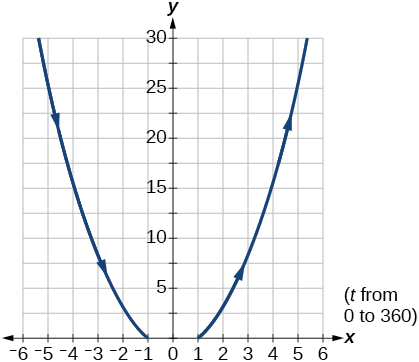
22)
For the exercises 23-27, graph the equation and include the orientation. Then, write the Cartesian equation.
23)
- Answer
-

24)
25)
- Answer
-
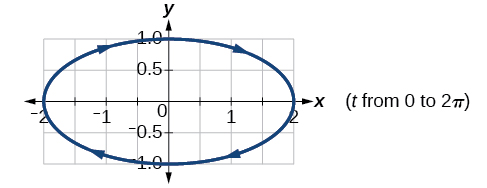
26)
27)
- Answer
-

For the exercises 28-33, graph the equation and include the orientation.
28)
29)
- Answer
-

30)
31)
- Answer
-
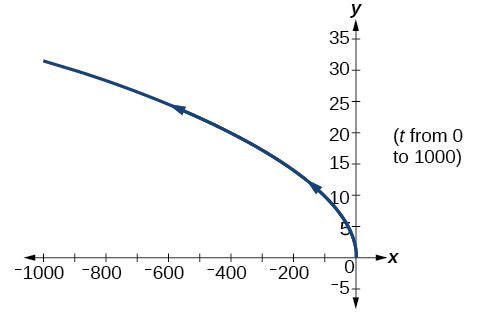
32)
33)
- Answer
-
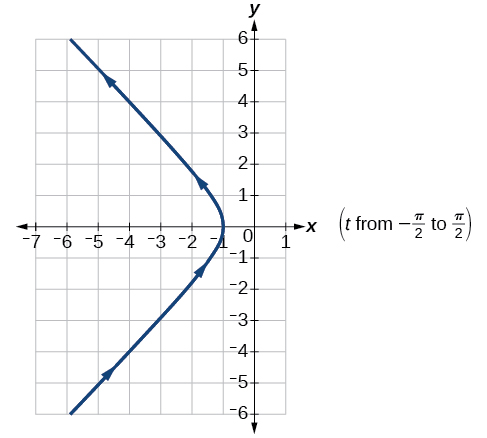
For the exercises 34-41, use the parametric equations for integers
34) Graph on the domain
35) Graph on the domain
- Answer
-
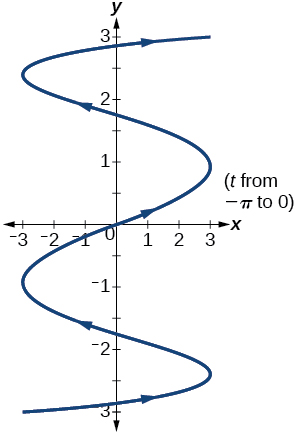
36) Graph on the domain
37) Graph on the domain
- Answer
-
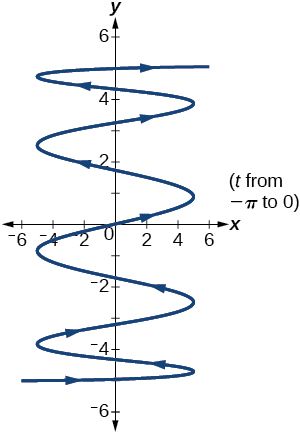
38) If
39) Describe the graph if
- Answer
-
There will be
40) What happens if
41) If the parametric equations
- Answer
-
Take the opposite of the
For the exercises 42-46, describe the graph of the set of parametric equations.
42)
43)
- Answer
-
The parabola opens up.
44)
45) Write the parametric equations of a circle with center
- Answer
-
46) Write the parametric equations of an ellipse with center
For the exercises 47-52, use a graphing utility to graph on the window
47)
- Answer
-
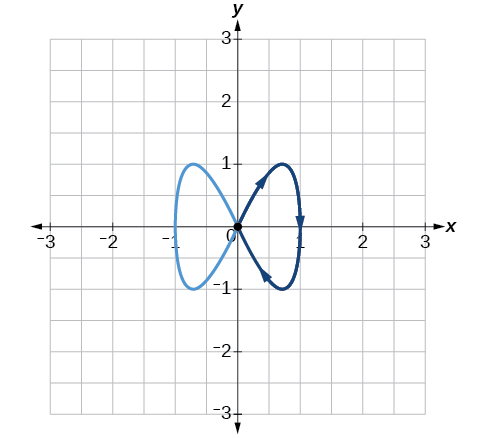
48)
49)
- Answer
-

50)
51)
- Answer
-
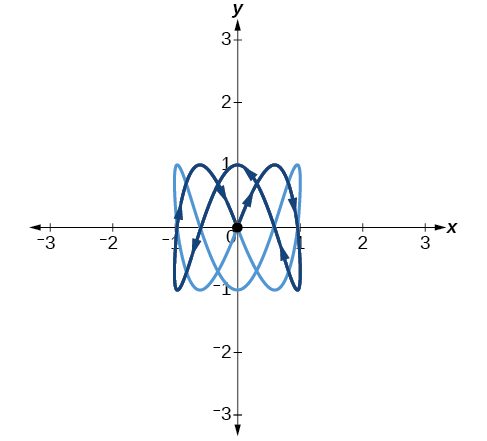
52)
Technology
For the exercises 53-56, look at the graphs that were created by parametric equations of the form
53)
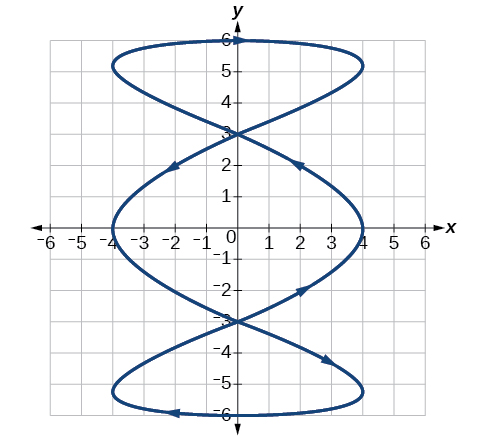
- Answer
-
54)
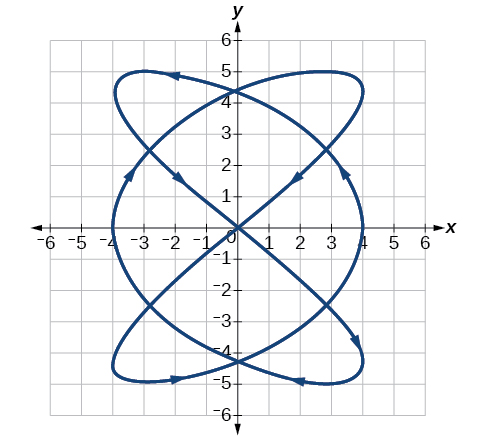
55)

- Answer
-
56)
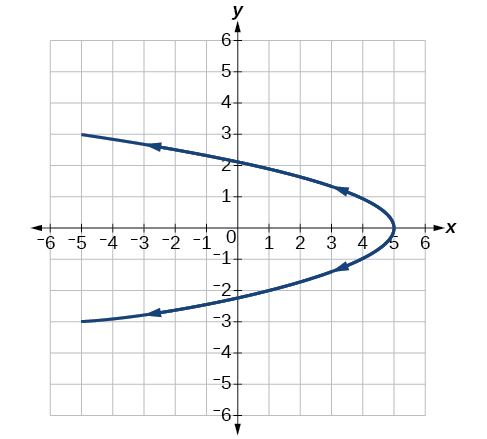
For the exercises 57-62, use a graphing utility to graph the given parametric equations.
57) Graph all three sets of parametric equations on the domain
- Answer
-
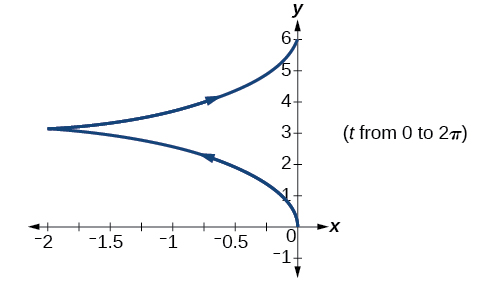
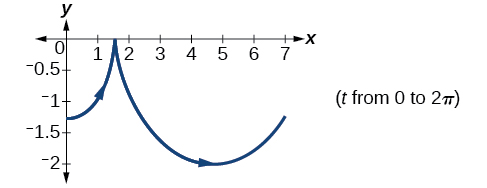
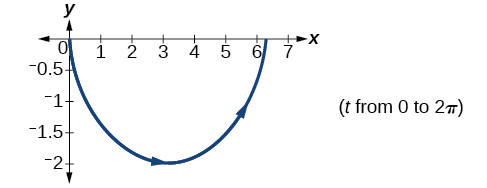
58) Graph all three sets of parametric equations on the domain
59) Graph all three sets of parametric equations on the domain
- Answer
-
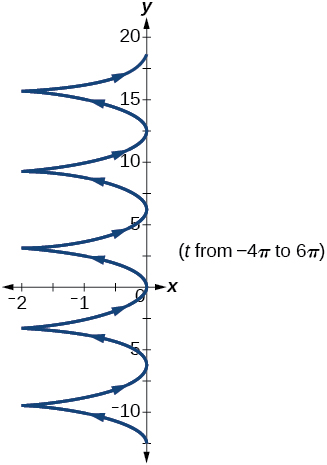
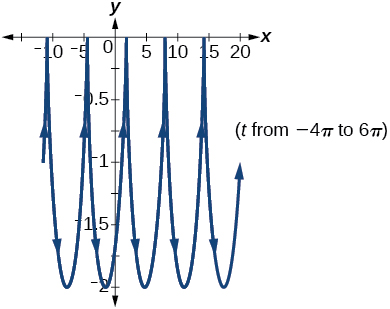
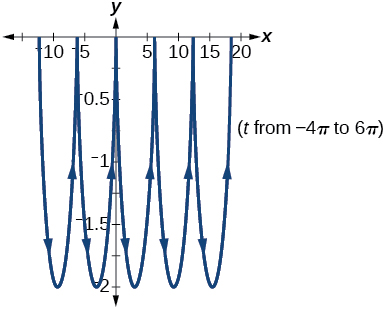
60) The graph of each set of parametric equations appears to “creep” along one of the axes. What controls which axis the graph creeps along?
61) Explain the effect on the graph of the parametric equation when we switched
- Answer
-
The
62) Explain the effect on the graph of the parametric equation when we changed the domain.
Extensions
63) An object is thrown in the air with vertical velocity of
- Answer
-
64) A skateboarder riding on a level surface at a constant speed of
For the exercises 65-69, use this scenario: A dart is thrown upward with an initial velocity of
65) Find parametric equations that model the problem situation.
- Answer
-
66) Find all possible values of
67) When will the dart hit the ground?
- Answer
-
approximately
68) Find the maximum height of the dart.
69) At what time will the dart reach maximum height?
- Answer
-
For the exercises 70-73, look at the graphs of each of the four parametric equations. Although they look unusual and beautiful, they are so common that they have names, as indicated in each exercise. Use a graphing utility to graph each on the indicated domain.
70)
71)
- Answer
-
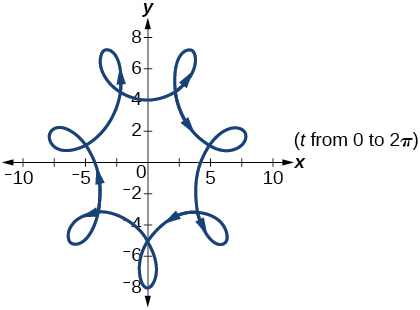
72)
73)
- Answer
-
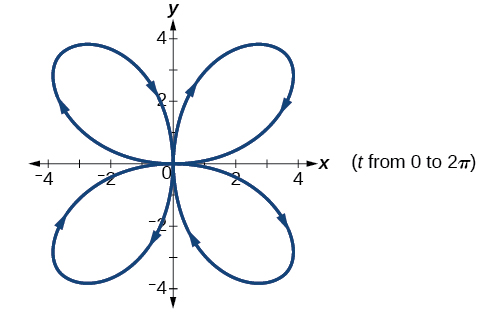
8.8: Vectors
Verbal
1) What are the characteristics of the letters that are commonly used to represent vectors?
- Answer
-
lowercase, bold letter, usually
2) How is a vector more specific than a line segment?
3) What are
- Answer
-
They are unit vectors. They are used to represent the horizontal and vertical components of a vector. They each have a magnitude of
4) What is component form?
5) When a unit vector is expressed as
- Answer
-
The first number always represents the coefficient of the
Algebraic
6) Given a vector with initial point
7) Given a vector with initial point
- Answer
-
8) Given a vector with initial point
For the exercises 9-15, determine whether the two vectors
9)
- Answer
-
not equal
10)
11)
- Answer
-
equal
12)
13)
- Answer
-
equal
14) Given initial point
15) Given initial point
- Answer
-
For the exercises 16-17, use the vectors
16) Find
17) Find
- Answer
-
For the exercises 18-21, use the given vectors to compute
18)
19)
- Answer
-
20) Let
21) Let
- Answer
-
For the exercises 22-27, find a unit vector in the same direction as the given vector.
22)
23)
- Answer
-
24)
25)
- Answer
-
26)
27)
- Answer
-
For the exercises 28-35, find the magnitude and direction of the vector,
28)
29)
- Answer
-
30)
31)
- Answer
-
32) Given
33) Given
- Answer
-
34) Given
35) Given
- Answer
-
Graphical
For the exercises 36-,38 given
36)
37)
- Answer
-

38)
For the exercises 39-41, use the vectors shown to sketch
39)

- Answer
-
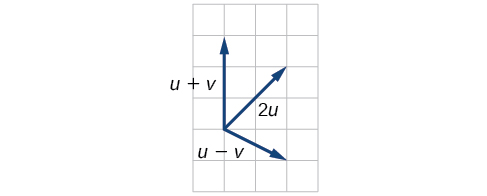
40)

41)
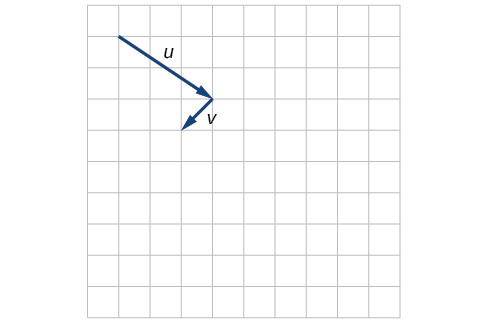
- Answer
-
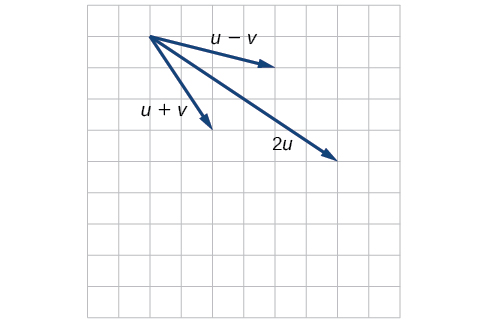
For the exercises 42-43, use the vectors shown to sketch
42)
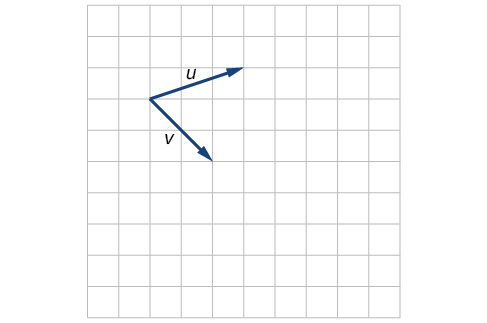
43)
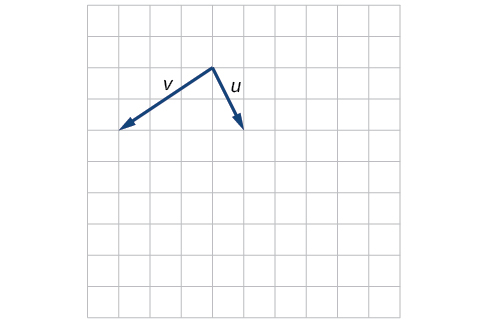
- Answer
-
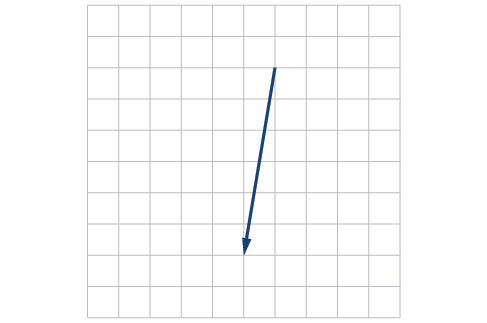
For the exercises 44-45, use the vectors shown to sketch
44)
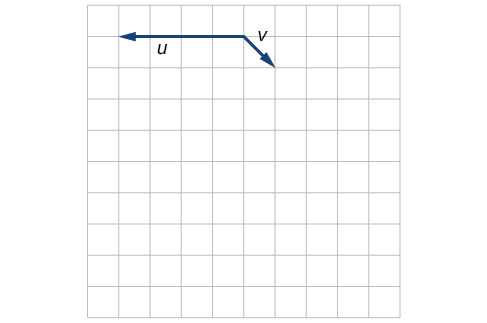
45)
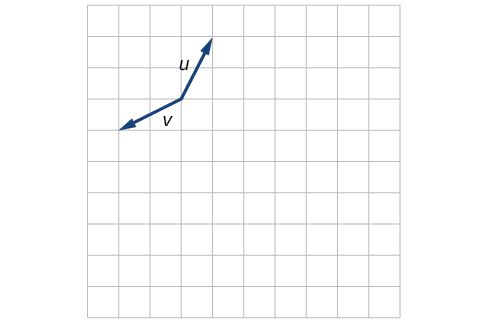
- Answer
-
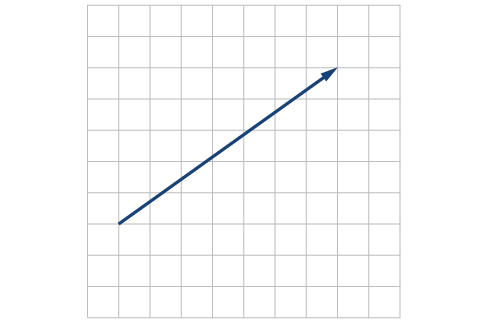
For the exercises 46-47, write the vector shown in component form.
46)

47)

- Answer
-
48) Given initial point
49) Given initial point
- Answer
-
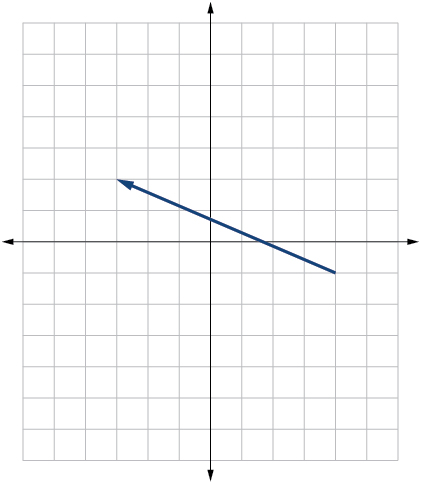
50) Given initial point
Extensions
For the exercises 51-54, use the given magnitude and direction in standard position, write the vector in component form.
51)
- Answer
-
52)
53)
- Answer
-
54)
55) A
- Find the magnitude of the normal (perpendicular) component of the force.
- Find the magnitude of the component of the force that is parallel to the ramp.
- Answer
-
56) A
- Find the magnitude of the normal (perpendicular) component of the force.
- Find the magnitude of the component of the force that is parallel to the ramp.
57) Find the magnitude of the horizontal and vertical components of a vector with magnitude
- Answer
-
58) Find the magnitude of the horizontal and vertical components of the vector with magnitude
59) Find the magnitude of the horizontal and vertical components of a vector with magnitude
- Answer
-
60) Find the magnitude of the horizontal and vertical components of the vector with magnitude
Real-World Applications
61) A woman leaves home and walks
- Answer
-
62) A boat leaves the marina and sails
63) A man starts walking from home and walks
- Answer
-
64) A woman starts walking from home and walks
65) A man starts walking from home and walks
- Answer
-
Distance:
66) A woman starts walking from home and walks
67) An airplane is heading north at an airspeed of
- Answer
-
68) An airplane is heading north at an airspeed of
69) An airplane needs to head due north, but there is a wind blowing from the southwest at
- Answer
-
70) An airplane needs to head due north, but there is a wind blowing from the northwest at
71) As part of a video game, the point
- Answer
-
72) As part of a video game, the point
73) Two children are throwing a ball back and forth straight across the back seat of a car. The ball is being thrown
- Answer
-
74) Two children are throwing a ball back and forth straight across the back seat of a car. The ball is being thrown
75) A
- Answer
-
parallel:
76) Suppose a body has a force of
77) Suppose a body has a force of
- Answer
-
78) The condition of equilibrium is when the sum of the forces acting on a body is the zero vector. Suppose a body has a force of
79) Suppose a body has a force of
- Answer
-
Contributors and Attributions
Jay Abramson (Arizona State University) with contributing authors. Textbook content produced by OpenStax College is licensed under a Creative Commons Attribution License 4.0 license. Download for free at https://openstax.org/details/books/precalculus.


